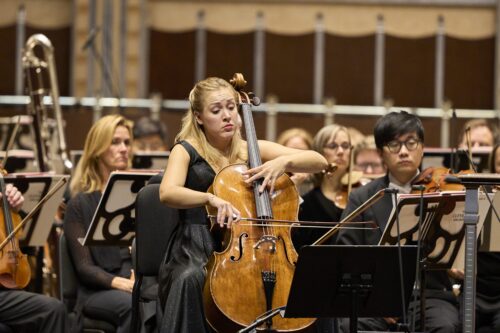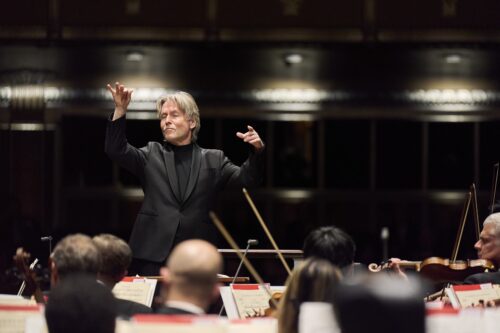 United States Ravel, Salonen, Sibelius: Senja Rummukainen (cello), Cleveland Orchestra / Esa-Pekka Salonen (conductor). Mandel Concert Hall at Severance Music Center, Cleveland, 13.10.2024. (MSJ)
United States Ravel, Salonen, Sibelius: Senja Rummukainen (cello), Cleveland Orchestra / Esa-Pekka Salonen (conductor). Mandel Concert Hall at Severance Music Center, Cleveland, 13.10.2024. (MSJ)

Ravel – Le Tombeau de Couperin
Esa-Pekka Salonen – Cello Concerto
Sibelius – Symphony No.5 in E-flat major
No one planned on having an exhibition of four potential future music directors to start the Cleveland Orchestra’s 2024/25 season, but that is what ended up happening. While some of the visitors may or may not have an interest in the position, at least Cleveland has an abundance of potential choices (which may be added to by upcoming concerts) for a successor to music director Franz Welser-Möst, who is leaving at the end of the 2026/27 season.
The opening two weeks of concerts became host to guest conductors when Welser-Möst called off to recuperate after the orchestra’s demanding European tour. Osmo Vänskä and Elim Chan came as fill-ins, and both brought the house down, Vänskä with a scorching Tchaikovsky Pathétique Symphony and Chan with a demonic rendition of Rachmaninoff’s Symphonic Dances. Daniel Harding followed with a richly noble account of Robert Schumann’s tricky Symphony No.2.
How are they as candidates? Vänskä, 71, is probably at the upper end of the age range that would be considered for a music directorship, though it is not old for a conductor in an age when many maestros have been active well into their nineties. The more relevant question would be, would Vänskä want the position after the soul-shredding debacle he experienced in Minnesota, with an overzealous board trying to cut expenses so much that the orchestra rebelled and ended up being locked out for over a year? Many fine players left and, after the dispute was resolved, Vänskä was left to rebuild the orchestra. He may well wish to steer clear of a music directorship as a result.
Chan, 37, is poised to leap into the big leagues and certainly merits further attention after her brilliant performances in Cleveland. It would be helpful to find out what she can do in more classical repertory such as Mozart or Beethoven. Harding at 49 is in a good position to move on as his long tenure with the Swedish Radio Symphony concludes this year, though his extensive catalogue of recordings suggests that he is not always ‘on’ like he was for the Schumann and, when he is not on, he becomes a sort of modern-day Lorin Maazel, who could turn icy cold if the music at hand did not hold his restless interest.
This weekend brought Esa-Pekka Salonen to town, a conductor who has visited Cleveland occasionally over the years without ever quite becoming a regular. But if Sunday’s concert is any indication, the orchestra would be blessed to have him around regularly: he brought both a mastery of podium leadership and a masterpiece of his own authorship, boosting him into the rare company of past conductors capable of real eloquence in composition. Longtime listeners to classical music may well have heard forgettable attempts by conductors such as Wilhelm Furtwängler, Otto Klemperer, Lorin Maazel and André Previn, who all wished to be remembered for their compositions which proved, alas, not very memorable. Only a rare few like Leonard Bernstein have wielded both the baton and pen with power.
There was a time when I would have lumped Salonen with the first group. His early compositions were fitfully interesting but constrained by the rigors of astringent modernism. He began to thaw and grow as a composer during his tenure with the Los Angeles Philharmonic, leading to a breakthrough into a new level of personal expression in his L.A. Variations. Until Sunday, I had not heard his recent Cello Concerto, written for Yo-Yo Ma, but after hearing it, I did a little experiment: I pulled out my phone and entered ‘Esa-Pekka Salonen’ in YouTube’s search function. The first suggestion that popped up? ‘Esa-Pekka Salonen Cello Concerto’, which tells you that there is a buzz growing behind this piece, and rightly so. Yo-Yo Ma was only the first of many international soloists who have embraced the work, and it is taking audiences by storm on its way to a likely permanent home in the repertory.
Salonen has opened his creative palette to embrace tonality, popular touches and moments of near-minimalism in this concerto, without ever sounding reactionary. Indeed, some listeners may have considered clutching their pearls upon entering Mandel Hall and finding packs of loudspeakers hanging from the proscenium arch and in far corners of the hall. Part of Salonen’s very up-to-date aesthetic is using live recording and looping technology in the cello solo, incorporating electronic processing to add reverb, echo and distortion. Many of these same people joined the shouting ovation at the end.
The work started off mysteriously, with sighing half-step falls in the lower strings taken over and elaborated by the cello, played here with blazing conviction by Senja Rummukainen in her Cleveland debut. These gestures grew into a sizeable first movement that combined a sense of searching with a visionary expansiveness. It was warm, inventive and moving music that offered as many dazzling concertante moments for the whole orchestra as for the cello alone.
As engaging as the first movement was, it did not telegraph the plunge into the depths that would come with the second movement, music that held listeners spellbound as it reached into remote, haunted soundscapes, abetted by the hallucinogenic looping. Rummukainen interacted fearlessly with her electronic double, proving that the important thing in music is expression: electronics can aid that process, briefly turning the storytelling cello into an otherworldly shaman.
The following finale combined joyful virtuosity with dance rhythms and an extended cadenza for cello, supported by a battery of bongos, congas and flexatone (played with joyful flair by Marc Damoulakis, the principal percussionist). All the cathartic energy finally coalesced in the solo cello, which climbed its way up to its highest register before the tones shot away like a comet in a final flourish of looping. The audience response was ecstatic – likely the warmest ovation I have heard for a new piece – and enthusiasm for Rummukainen resulted in an encore: the Variations in D minor for solo cello by Sibelius.

The concert had opened with a wise performance of Le Tombeau de Couperin by Maurice Ravel. The piece, ostensibly a tribute to the French Baroque, is too often tossed off as a virtuoso show piece. Salonen has clearly considered two things: one, that music of the French Baroque is more about elegant color than display; and two, that Ravel dedicated each movement of the work to a friend whom he lost during World War I. Instead of aiming for facile brilliance, Salonen etched the work’s details with care, Frank Rosenwein’s oboe providing variegated colors in the flowing Prélude and the poised but pained Menuet. Piquant dissonances were allowed to sound out, with only the final Rigaudon arguably losing a little clarity to a brisk tempo. Salonen conducted the piece without a baton, rounding off the orchestral sound.
Salonen recorded the Sibelius Symphony No.5 in his youth, but that was a mere rehearsal for what he would someday do with the piece, judging by this performance. The first movement was conceived as one long arch, gradually accelerating with numerous small adjustments in pace. But such technical considerations were in the background, as the conductor found the inner life of the music which made those tricky adjustments fall into place as if it were the most natural thing in the world. The second movement was gentle, leading to a surprisingly spacious and downright radiant finale. The famous ‘swan theme’ (inspired by a flight of wild geese, according to the composer) was a thing of wonder, showing how far the Cleveland Orchestra has come in the horn section since the 1980s, when I first began attending concerts. In those days, the horns lacked the ability to soar the way they do now and, wow, did they soar. The whole performance was one of surpassing beauty, gravity and warmth – elements that once were not spoken in the same breath with the name Esa-Pekka Salonen. How things have changed, and what a humane, mature artist he has become.
This concert was almost certainly scheduled before Salonen became a potential candidate for Cleveland. But a budget hatchet-job by the San Francisco Symphony’s board of directors has led him to submit his resignation there, effective at the end of the 2024/25 season, after recently beginning a tenure that had already resulted in considerable acclaim. Would Salonen consider another directorship after that kind of a jump scare? At 66, Salonen is only five years younger than Vänskä, at a time when the Cleveland Orchestra may well be casting their net for a younger director. And Salonen’s comparative weak spot, the classical repertory of Beethoven and Brahms, are core staples in Cleveland’s tradition.
But mastery and magic are powerful things. Consider this: at the end of the Sibelius, Salonen indicated the final chord decisively with his baton (he used it for the symphony and his concerto), then brought his arm back, wrapping it around himself. A roar of applause began, but the conductor did not release that self-embrace, trembling, perhaps for a moment overcome by the beauty of the music making. When he did finally release his tension, the ovation quickly grew into a frenzy. When Salonen returned to the stage a second time, the Cleveland Orchestra did something extremely rare: they refused to stand, stomping their feet until Salonen took a solo bow.
That says a lot.
Mark Sebastian Jordan
